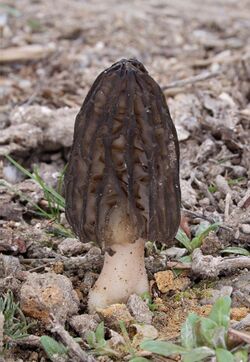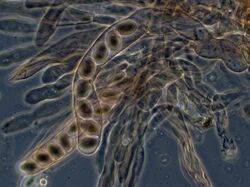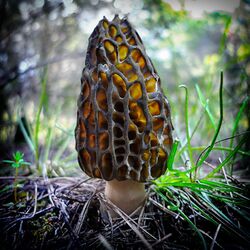Biology:Morchella elata
| Morchella elata | |
|---|---|

| |
| Black morel near Ulm, Germany | |
| Scientific classification | |
| Domain: | Eukaryota |
| Kingdom: | Fungi |
| Division: | Ascomycota |
| Class: | Pezizomycetes |
| Order: | Pezizales |
| Family: | Morchellaceae |
| Genus: | Morchella |
| Species: | M. elata
|
| Binomial name | |
| Morchella elata Fr. (1822)
| |
| Morchella elata | |
|---|---|
| Mycological characteristics | |
| smooth hymenium | |
| cap is conical | |
| hymenium attachment is not applicable | |
| stipe is bare | |
| edibility: edible or can cause allergic reactions | |
Morchella elata is a species of fungus in the family Morchellaceae. It is one of many related species commonly known as black morels, and until 2012 the name M. elata was broadly applied to black morels throughout the globe.[1][2] Like most members of the genus, M. elata is a popular edible fungus and is sought by many mushroom hunters.
Taxonomy and phylogeny
The fruit bodies of Morchella species, including M. elata, are highly polymorphic in appearance, exhibiting variations in shape, color and size; this has contributed to uncertainties regarding taxonomy.[3] Discriminating between the various species is complicated by uncertainty regarding which species are truly biologically distinct. Mushroom hunters refer to them by their color as the species are very similar in appearance and vary considerably within species and age of individual.
Early phylogenetic analyses supported the hypothesis that the genus comprises only a few species with considerable phenotypic variation.[4][5] More recent DNA work, however, has revealed more than a dozen distinct groups of morels in North America,[6] and over 60 worldwide.[7] An extensive DNA study showed three discrete clades, or genetic groups, consisting of the black morels (Morchella elata and others), the yellow morels (Morchella esculenta and others), and the white morels (Morchella rufobrunnea and Morchella anatolica). Species within the Elata clade (also referred to as Distantes), are characterised by the gradual darkening of their sterile ridges upon maturity, with the exception of Morchella tridentina (=Morchella frustrata), which has persistently pale ridges.[8] Within the black and yellow clades, there are dozens of individual species, many endemic to individual continents or regions.[1] This species-rich view is supported by studies in North America,[1] Western Europe,[9] Turkey,[10][11] Israel,[12] the Himalayas,[13] and China .[7]
The scientific name Morchella elata was proposed by Elias Magnus Fries from Sweden in 1822.[14] DNA analysis in 2011 has shown North American black morels to be largely distinct from European species,[1] therefore restricting the use of the M. elata name to Europe. In 2012, Kuo et al. provided names for many of the North American black morels that may have been referred to as M. elata in the past.[2] However, in a subsequent study by Richard et al. (2014) proposing a unified taxonomy for the genus, it is suggested that Fries' original description of Morchella elata may correspond to phylogenetic lineage Mel-10, which has been since described from North America as Morchella importuna, but later shown to have a widespread transcontinental distribution.
The variety M. elata var. purpurescens, characterised by the purple- or pink-colored tinges of its ascocarps,[15] is now considered to belong to a phylogenetically distinct lineage (Richard et al. 2014).
|
Eastern North America
|
Western North America
|
|
Description

Morchella elata has operculate asci (i.e., asci opening by an apical lid to discharge the spores). It further has unicellular hyaline ascospores with polar oil droplets.[16]
Despite the fact that many interpretations of M. elata exist throughout the years, most authors agree that Fries' original concept refers to a species with dark, conical ascocarps and more or less parallel vertical ridges, with horizontal interconnecting ridges arranged in a "ladderlike" pattern.[17][18][19][20][21]
This is an edible species, although like other morels, some individuals may be allergic to it, so it must be cooked before being eaten.[22] It can also be dried for later use.[23] However, according to one field guide it may cause gastrointestinal disorder, and cannot easily be identified without a microscope.[24]
Ecology and distribution
Morchella elata fruits during spring on soil. Fries' original description, which was based on a collection from a fir wood in Sweden, reported it as rare: "In silvis abiegnis, praecipue locis humidis adustis, raro". However, since the true identity of M. elata is not yet fully clarified, its exact ecological preferences and distribution remain unclear.
Toxicity
Morels contain small amounts of hydrazine[25] toxins or an unknown toxin that are destroyed through cooking, (the presence of hydrazine is controversial since there are no primary references of hydrazine having been detected in the species), so morel mushrooms should never be eaten raw.[26] It has been reported that even cooked morels can sometimes cause mild intoxication symptoms when consumed with alcohol.[27]
See also
- False morel
- Cryptic species complex
References
- ↑ 1.0 1.1 1.2 1.3 "Phylogeny and historical biogeography of true morels (Morchella) reveals an early Cretaceous origin and high continental endemism and provincialism in the Holarctic". Fungal Genetics and Biology 48 (3): 252–265. Mar 2011. doi:10.1016/j.fgb.2010.09.006. PMID 20888422.
- ↑ 2.0 2.1 "Taxonomic revision of true morels (Morchella) in Canada and the United States". Mycologia 104 (5): 1159–77. 11 April 2012. doi:10.3852/11-375. PMID 22495449. http://thekeep.eiu.edu/cgi/viewcontent.cgi?article=1192&context=bio_fac.
- ↑ Segula Masaphy; Limor Zabari; Doron Goldberg; Gurinaz Jander-Shagug (Spring 2010). "The Complexity of Morchella Systematics: A Case of the Yellow Morel from Israel". Fungi Magazine 3 (2): 14–18. http://www.fungimag.com/special-spring-2010-articles/YellowMorel.pdf.
- ↑ Bunyard, B. A.; Nicholson, M. S.; Royse, D. J. (1994). "A systematic assessment of Morchella using RFLP analysis of the 28S ribosomal gene". Mycologia 86 (6): 762–772. doi:10.2307/3760589.
- ↑ Bunyard, B. A.; Nicholson, M. S.; Royse, D. J. (1995). "Phylogenetic resolution of Morchella, Verpa, andDisciotis (Pezizales: Morchellaceae) based on restriction enzyme analysis of the 28S ribosomal RNA gene". Experimental Mycology 19 (3): 223–233. doi:10.1006/emyc.1995.1027. PMID 7553270.
- ↑ Kuo, M. (March 2006). "Morel Data Collection Project: Preliminary results". http://www.mushroomexpert.com/mdcp/ndex.html.
- ↑ 7.0 7.1 Du, X.-H.; Zhao, Q.; O’Donnell, K.; Rooney, A. P.; Yang, Z. L. (2012). "Multigene molecular phylogenetics reveals true morels (Morchella) are especially species-rich in China". Fungal Genetics and Biology 49 (6): 455–469. doi:10.1016/j.fgb.2012.03.006. PMID 22503770.
- ↑ Loizides, Michael; Alvarado, Pablo; Clowez, Philippe; Moreau, Pierre-Arthur; de la Osa, Luis Romero; Palazón, Antonio (2015). "Morchella tridentina, M. rufobrunnea, and M. kakiicolor: a study of three poorly known Mediterranean morels, with nomenclatural updates in section Distantes". Mycol Progress 14 (3). doi:10.1007/s11557-015-1030-6.
- ↑ Harald Kellner; Carsten Renker; François Buscot (2005). "Species diversity within the Morchella esculenta group (Ascomycota: Morchellaceae) in Germany and France". Organisms, Diversity & Evolution 5 (2): 101–107. doi:10.1016/j.ode.2004.07.001. http://www.osiris.ufz.de/data/Kellner%202005%20Morchella%20Germany%20and%20France3634.pdf. Retrieved 2012-02-20.
- ↑ Hatıra Taşkına; Saadet Büyükalacaa; Hasan Hüseyin Doğanb; Stephen A. Rehnerc; Kerry O'Donnell (Aug 2010). "A multigene molecular phylogenetic assessment of true morels (Morchella) in Turkey". Fungal Genetics and Biology 47 (8): 672–682. doi:10.1016/j.fgb.2010.05.004. PMID 20580850.
- ↑ Taşkın, H.; Büyükalaca, S.; Hansen, K.; O’Donnell, K. (March–April 2012). "Multilocus phylogenetics analysis of true morels (Morchella) reveals high levels of endemics in Turkey relative to other regions of Europe". Mycologia 104 (2): 446–461. doi:10.3852/11-180. PMID 22123659. http://www.mycologia.org/content/104/2/446.
- ↑ S. Masaphy; L. Zabari; D. Goldberg (2009). "New long-season ecotype of Morchella rufobrunnea from northern Israel". Micologia Aplicada International 21 (2): 45–55. https://www.redalyc.org/pdf/685/68511349005.pdf. Retrieved 2012-02-20.
- ↑ "Molecular Characterization of Morchella Species from the Western Himalayan Region of India". Current Microbiology 62 (4): 1245–1252. Dec 25, 2010. doi:10.1007/s00284-010-9849-1. PMID 21188589.
- ↑ Fries EM (1822). Systema Mycologicum. 2. Lundin, Sweden: Ex Officina Berlingiana. p. 8. https://www.biodiversitylibrary.org/page/4335151.
- ↑ Phillips R. "Morchella elata". Rogers Mushrooms. http://www.rogersmushrooms.com/gallery/DisplayBlock~bid~6467.asp.
- ↑ Parguey-Leduc, A; Janex-Favre, M-C; Bruxelles, G (1998). "Comparative study of the asci and ascospores of some Morels (Genus Morchella, Ascomycetes)". Cryptogamie, Bryologie, Lichénologie 19 (2–3): 277–292.
- ↑ Boudier E (1897) Révision analytique des morilles de France. Bull. Soc. Mycol. Fr. 13 : 130-150.
- ↑ Boudier E (1909) Icones mycologicae ou iconographie des champignons de France principalement discomycètes avec texte descriptif. Tome II, pl. 194–421. Librairie des Sciences Naturelles, Paris
- ↑ Breitenbach J, Kränzlin F (1984) Fungi of Switzerland, Volume 1: Ascomycetes. Verlag Mykologia, Luzern, Switzerland
- ↑ Clowez P (2010) Les morilles: Une nouvelle approche mondiale du genre Morchella. Bulletin trimestriel de la Société mycologique de France 126 (3-4): 199–376.
- ↑ Richard, Franck; Bellanger, Jean-Michel; Clowez, Philippe; Courtecuisse, Regis; Hansen, Karen; O'Donnell, Kerry; Sauve, Mathieu; Urban, Alexander et al. (2014). "True morels (Morchella, Pezizales) of Europe and North America: evolutionary relationships inferred from multilocus data and a unified taxonomy". Mycologia 107 (2): 359–82. doi:10.3852/14-166. PMID 25550303.
- ↑ Phillips, Roger (2010). Mushrooms and Other Fungi of North America. Buffalo, NY: Firefly Books. p. 361. ISBN 978-1-55407-651-2. https://archive.org/details/mushroomsotherfu0000phil.
- ↑ Miller Jr., Orson K.; Miller, Hope H. (2006). North American Mushrooms: A Field Guide to Edible and Inedible Fungi. Guilford, CN: FalconGuides. pp. 503. ISBN 978-0-7627-3109-1.
- ↑ Whitney, Stephen (1985). Western Forests (The Audubon Society Nature Guides). New York: Knopf. pp. 497–98. ISBN 0-394-73127-1. https://archive.org/details/westernforests00whit/page/497.
- ↑ Stamets, Paul (2005). Mycelium Running. Berkeley: Ten Speed Press. p. 271. ISBN 978-1-58008-579-3. https://archive.org/details/myceliumrunningh00stam_0/page/271.
- ↑ Hall, Ian R.; Buchanan, Peter K. (2003). Edible and poisonous mushrooms of the world. Timber Press. ISBN 978-0-88192-586-9.
- ↑ Groves, J. Walton (1964). "Poisoning by Morels When Taken with Alcohol". Mycologia 56 (5): 779–780. doi:10.2307/3756634.
External links
Wikidata ☰ Q627991 entry
fi:Kartiohuhtasieni
 |


